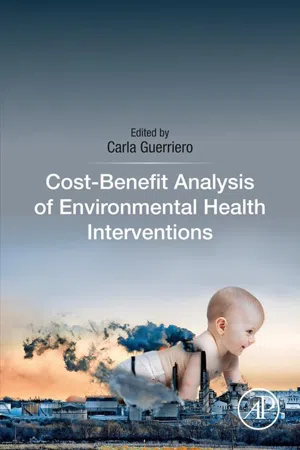
- 310 pages
- English
- ePUB (mobile friendly)
- Available on iOS & Android
Cost-Benefit Analysis of Environmental Health Interventions
About This Book
Cost-benefit Analysis of Environmental Health Interventions clearly articulates the core principles and fundamental methodologies underpinning the modern economic assessment of environmental intervention on human health. Taking a practical approach, the book provides a step-by-step approach to assigning a monetary value to the health benefits and disbenefits arising from interventions, using environmental information and epidemiological evidence. It summarizes environmental risk factors and explores how to interpret and understand epidemiological data using concentration-response, exposure-response or dose-response techniques, explaining the environmental interventions available for each environmental risk factor. It evaluates in detail two of the most challenging stages of Cost-Benefit Analysis in 'discounting' and 'accounting for uncertainty'. Further chapters describe how to analyze and critique results, evaluate potential alternatives to Cost-Benefit Analysis, and on how to engage with stakeholders to communicate the results of Cost-Benefit Analysis. The book includes a detailed case study how to conduct a Cost-Benefit Analysis. It is supported by an online website providing solution files and detailing the design of models using Excel.
- Provides a clear understanding of the core theory of cost-benefit analysis in environmental health interventions
- Provides practical guidance using real-world case studies to motivate and expand understanding
- Describes the challenging 'discounting' and 'accounting for uncertainty' problems at chapter length
- Supported by a practical case study, online solution files, and a practical guide to the design of CBA models using Excel
Frequently asked questions
Information
The key steps in cost–benefit analysis of environmental health interventions
Abstract
Keywords
1.1 Introduction

1.2 Step 1: Identifying the decision problem to be addressed and the alternatives to include
- 1. Financial: This type of CBA meets the criteria of private assessment regardless of the subject involved. The objective is to chime with the maximization of profit according to the criteria of financial efficiency.
- 2. Economic: This CBA meets public evaluation criteria that vary according to the nature of the subject involved (e.g., Minister of Health or Education or Transport). In this case the objective is the maximization of the social well-being according to the criteria of economic efficiency. This CBA considers all possible determinant effects of the intervention beyond “market prices.”
- 3. Societal: This CBA meets public evaluation criteria but also takes into account the effects of the investments on equity and income distribution. The reference parameters for this analysis are social prices, that is, those established on the basis of the references of public decision makers with the aim of improving temporal and spatial distributions of income. This is the most comprehensive but also the most challenging type of CBA.
Table of contents
- Cover image
- Title page
- Table of Contents
- Copyright
- Dedication
- List of contributors
- Acknowledgments
- Introduction
- Chapter 1. The key steps in cost–benefit analysis of environmental health interventions
- Chapter 2. Environmental health interventions for the treatment of waters, solids, and soils
- Chapter 3. Health impact assessment: quantifying the health benefits and costs
- Chapter 4. Monetary analysis of health outcomes
- Chapter 5. Health benefit analysis: monetization of health impacts and its use in environment and health
- Chapter 6. Costing environmental health intervention
- Chapter 7. Discounting benefits and costs
- Chapter 8. Quantifying uncertainty in environmental health models
- Chapter 9. Alternatives to cost–benefit analysis for economic evaluation
- Chapter 10. Climate change and ecological public health: an integrated framework
- Chapter 11. Case study: a realistic contaminated site remediation and different scenarios of intervention
- Chapter 12. Conclusion
- Index